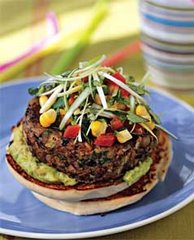My seven year old is a vegetarian. When she started her quest of avoiding meat we thought just cutting out meat itself would be enough, but it has become a journey of shocking, jaw-dropping discovery at just what contains ground-up animal parts. As a result, I am now a veggie. So I have gone from researching good recipes and nutritional information, which is essential for such a young vegetarian, to the family taking on a healthier, more compassionate outlook on life.
Sunday, 15 April 2007
Fur and leather, say no more......
I appear to live in a naïve little world, or perhaps I am just ignorant and unthinking about the things that go on around me, but I am constantly aghast as I look into vegetarianism and its other possible spheres, and discover the treatment of animals, how have I got to the age I am and never questioned it before?
Obviously, I am not so ignorant that I haven’t realised before now that animals have to die so we can have comfy boots and leather jackets, but it is the treatment of the animals that upsets me. Without sounding like an hysterical woman, why can’t they be treated with a bit more respect? They have feelings too, and I don’t mean in the ‘it wasn’t what you said, it was the way you said it’ way, I mean they feel pain, just like us, and by the sound of it, they spend their whole lives in physical discomfort until they have the welcome release of a knock on the head.
Included below are two very good, if harrowing, descriptions of how animals are treated for the procurement of fur and leather, found on the Vegetarian Society website, for full details visit: http://www.vegsoc.org/info/clothing.html.
Leather
Should vegetarians wear leather? That's a question we hear all the time. Some people think it is OK because leather is just a by-product of the meat industry and the animals weren't killed just for their skins. Others seem to believe that there's a strong chance the animal died naturally. But neither excuse really holds water.
Very few farm animals in this country ever reach the natural end of their lifespan, most are killed when they are little more than adolescents. The remaining ones go for slaughter because they are worn out by a lifetime of continuous breeding and/or lactation and artificially heightened fertility.
The leather we like best, soft leather, doesn't come from old cows at all, it comes from calves and the softest leather of all comes from unborn calves whose mothers have been slaughtered.
And leather might be just a by-product, but it's a very important one for the meat trade. About 10% of the value of the animal at the abattoir is in its skin, worth about 650 million pounds a year in the UK, so by buying leather, we are helping to support the meat industry.
Domestic animals aren't the only ones to be used for leather production, the list includes deer, alligators, crocodile, toads, ostriches, kangaroos, lizards, snakes and seals. Many of these are already endangered species but the high prices commanded by their skins make it very tempting for impoverished natives to poach.
And although we are far from convinced that death in a slaughterhouse is humane, some attempt at least is made to stun the animals first. Wild species killed for leather have no protection at all, they may be clubbed to death or caught in cruel traps. A report in the American magazine Animals Agenda (March 1991) suggests snakes and lizards are routinely skinned alive because dealers believe this makes the finished skin more supple. Studies by herpetologists found that alligators and other reptiles could survive live skinning, taking nearly two hours to die afterwards.
Finding alternatives to leather is not quite as easy as finding alternative vegetarian foods, but we should certainly do what we can. For example, no-one needs to buy handbags, purses, wallets and belts made from leather, plenty of acceptable alternatives are available. Finding alternatives to leather clothing designed specifically for protection, like heavy-duty shoes and motorcycling leathers is not so easy but do keep on asking. It is very important to let manufacturers and retailers know that there is a demand for alternatives to leather.
Some people will say that leather is a natural, eco-friendly product but the leather industry is a major source of pollution. Tanneries are often sited near rivers as the process needs a plentiful supply of water and the waste - including hair, salt, lime, sludge, acids and chrome - is discharged into the river.
More information from: Campaign Against Leather and Fur, BM 8889, London WC1N 3XX
Fur
Most people know about the cruelties involved in obtaining fur. The animals are either trapped wild or farmed. Both methods of production involve cruelty.
Wild trapping can mean endangered species being wiped out, besides the individual suffering of animals caught in steel-jawed leg hold traps. Some animals go to desperate lengths to escape, often gnawing off part of their own leg or paw.
The traps do not discriminate, so other animals may also be destroyed or maimed, including some domestic animals. As many as 50% of the animals caught in traps will be no use to the fur trade, which refers to them as "trash animals".
Farmed animals, principally mink and arctic fox, are kept imprisoned all their lives in tiny cages. Fur farming is a vast industry with more than 40 million animals being raised in intensive conditions, mainly in North America and Scandinavia.
Consider what it must be like for a creature like the arctic fox, which naturally roams a territory of about 15,000 acres, to spend its life in a cage measuring just a few cubic feet.
Animals like mink are often introduced into a country by accident when they escape from fur farms, posing a threat to native wildlife. For example, it was reported in New Scientist (30.3.91) that water voles in North Yorkshire are under threat from mink who not only prey on them but also take over their breeding sites. The mink population is increasing but the future looks bleak for the voles.
In Britain, there is no legal requirement for the farmers to be trained in methods of slaughtering their livestock.
More Information:
Operation Fur Factory, PO Box 87, Rochdale, Lancs, OL16 1AA.
No Fur Campaign, WSPA, Park Place, 10 Lawn Lane, London, SW8 1UD. Tel: 071 793 0540
Respect for Animals, PO Box 500, Nottingham NG1 3AS.
Source: http://www.vegsoc.org/info/clothing.html
What is worth a look is the Vegetarian Society classifieds, where they have listings of animal friendly clothes and shoes, ttp://www.vegsoc.org/directory/clothing.html
Obviously, I am not so ignorant that I haven’t realised before now that animals have to die so we can have comfy boots and leather jackets, but it is the treatment of the animals that upsets me. Without sounding like an hysterical woman, why can’t they be treated with a bit more respect? They have feelings too, and I don’t mean in the ‘it wasn’t what you said, it was the way you said it’ way, I mean they feel pain, just like us, and by the sound of it, they spend their whole lives in physical discomfort until they have the welcome release of a knock on the head.
Included below are two very good, if harrowing, descriptions of how animals are treated for the procurement of fur and leather, found on the Vegetarian Society website, for full details visit: http://www.vegsoc.org/info/clothing.html.
Leather
Should vegetarians wear leather? That's a question we hear all the time. Some people think it is OK because leather is just a by-product of the meat industry and the animals weren't killed just for their skins. Others seem to believe that there's a strong chance the animal died naturally. But neither excuse really holds water.
Very few farm animals in this country ever reach the natural end of their lifespan, most are killed when they are little more than adolescents. The remaining ones go for slaughter because they are worn out by a lifetime of continuous breeding and/or lactation and artificially heightened fertility.
The leather we like best, soft leather, doesn't come from old cows at all, it comes from calves and the softest leather of all comes from unborn calves whose mothers have been slaughtered.
And leather might be just a by-product, but it's a very important one for the meat trade. About 10% of the value of the animal at the abattoir is in its skin, worth about 650 million pounds a year in the UK, so by buying leather, we are helping to support the meat industry.
Domestic animals aren't the only ones to be used for leather production, the list includes deer, alligators, crocodile, toads, ostriches, kangaroos, lizards, snakes and seals. Many of these are already endangered species but the high prices commanded by their skins make it very tempting for impoverished natives to poach.
And although we are far from convinced that death in a slaughterhouse is humane, some attempt at least is made to stun the animals first. Wild species killed for leather have no protection at all, they may be clubbed to death or caught in cruel traps. A report in the American magazine Animals Agenda (March 1991) suggests snakes and lizards are routinely skinned alive because dealers believe this makes the finished skin more supple. Studies by herpetologists found that alligators and other reptiles could survive live skinning, taking nearly two hours to die afterwards.
Finding alternatives to leather is not quite as easy as finding alternative vegetarian foods, but we should certainly do what we can. For example, no-one needs to buy handbags, purses, wallets and belts made from leather, plenty of acceptable alternatives are available. Finding alternatives to leather clothing designed specifically for protection, like heavy-duty shoes and motorcycling leathers is not so easy but do keep on asking. It is very important to let manufacturers and retailers know that there is a demand for alternatives to leather.
Some people will say that leather is a natural, eco-friendly product but the leather industry is a major source of pollution. Tanneries are often sited near rivers as the process needs a plentiful supply of water and the waste - including hair, salt, lime, sludge, acids and chrome - is discharged into the river.
More information from: Campaign Against Leather and Fur, BM 8889, London WC1N 3XX
Fur
Most people know about the cruelties involved in obtaining fur. The animals are either trapped wild or farmed. Both methods of production involve cruelty.
Wild trapping can mean endangered species being wiped out, besides the individual suffering of animals caught in steel-jawed leg hold traps. Some animals go to desperate lengths to escape, often gnawing off part of their own leg or paw.
The traps do not discriminate, so other animals may also be destroyed or maimed, including some domestic animals. As many as 50% of the animals caught in traps will be no use to the fur trade, which refers to them as "trash animals".
Farmed animals, principally mink and arctic fox, are kept imprisoned all their lives in tiny cages. Fur farming is a vast industry with more than 40 million animals being raised in intensive conditions, mainly in North America and Scandinavia.
Consider what it must be like for a creature like the arctic fox, which naturally roams a territory of about 15,000 acres, to spend its life in a cage measuring just a few cubic feet.
Animals like mink are often introduced into a country by accident when they escape from fur farms, posing a threat to native wildlife. For example, it was reported in New Scientist (30.3.91) that water voles in North Yorkshire are under threat from mink who not only prey on them but also take over their breeding sites. The mink population is increasing but the future looks bleak for the voles.
In Britain, there is no legal requirement for the farmers to be trained in methods of slaughtering their livestock.
More Information:
Operation Fur Factory, PO Box 87, Rochdale, Lancs, OL16 1AA.
No Fur Campaign, WSPA, Park Place, 10 Lawn Lane, London, SW8 1UD. Tel: 071 793 0540
Respect for Animals, PO Box 500, Nottingham NG1 3AS.
Source: http://www.vegsoc.org/info/clothing.html
What is worth a look is the Vegetarian Society classifieds, where they have listings of animal friendly clothes and shoes, ttp://www.vegsoc.org/directory/clothing.html
Subscribe to:
Post Comments (Atom)
































No comments:
Post a Comment